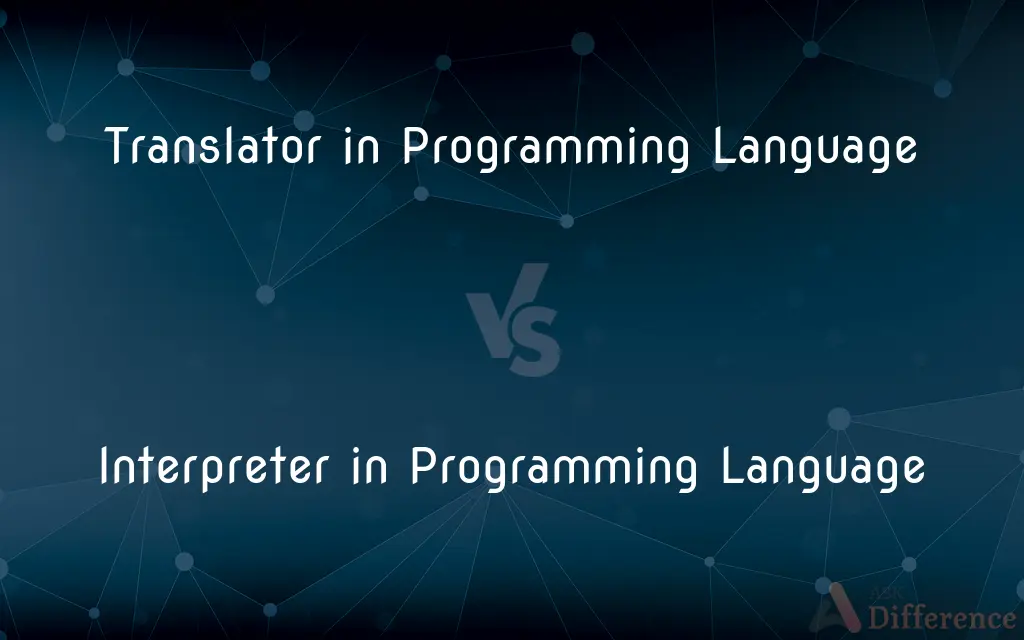Translator in Programming Language vs. Interpreter in Programming Language — What's the Difference?
By Tayyaba Rehman — Published on December 17, 2023
A Translator in Programming Language converts source code into machine code all at once. An Interpreter in Programming Language translates and executes source code line by line, on-the-fly.

Difference Between Translator in Programming Language and Interpreter in Programming Language
Table of Contents
ADVERTISEMENT
Key Differences
In the realm of programming languages, a Translator is a tool that takes source code written by programmers and translates it entirely into another form, commonly machine code or an intermediate code. This process is typically done in one sweep, and the resulting output can be executed independently. On the contrary, an Interpreter in Programming Language works a bit differently, as it translates source code line by line and executes it immediately, rather than translating the entire program beforehand.
The fundamental difference between a Translator and an Interpreter in Programming Language lies in their operation. While a Translator translates the entire code at once and produces an output, an Interpreter goes through the code line by line, interpreting and executing it on-the-fly. This means that with an Interpreter, no separate compiled output is generated.
From an efficiency standpoint, programs that have been processed using a Translator in Programming Language often run faster. This is because the translation is done beforehand, and during execution, there's no need for on-the-spot translation. In contrast, an Interpreter in Programming Language might be slower since it has to translate and execute code simultaneously. However, Interpreters offer more flexibility, especially during the development phase, as changes can be made and tested without going through a separate compilation step.
Regarding debugging, an Interpreter in Programming Language may provide more immediate feedback since it operates line by line. If there's an error, the Interpreter stops at the problematic line, allowing for easier identification of issues. Meanwhile, a Translator in Programming Language will typically compile the entire program, and errors might only become apparent during the program's execution, potentially making it harder to pinpoint the exact location of a problem.
Comparison Chart
Operation Method
Translates entire code at once.
Translates and executes code line by line.
ADVERTISEMENT
Execution Speed
Generally faster during execution.
Might be slower due to on-the-fly translation.
Flexibility During Development
Requires recompilation after changes.
Changes can be tested immediately without recompilation.
Error Identification
Errors identified after translation, during execution.
Immediate feedback; identifies errors line by line.
Output Generated
Produces a separate output file (e.g., executable).
No separate output; interprets directly from source.
Compare with Definitions
Translator in Programming Language
Often used in compiled languages like C or C++.
In C, a Translator in Programming Language transforms source code into an executable format.
Interpreter in Programming Language
A tool that translates and executes source code line by line.
The Interpreter in Programming Language began reading the script, acting on each instruction immediately.
Translator in Programming Language
Requires recompilation for every code change.
After making modifications, we used the Translator in Programming Language again to generate a new output.
Interpreter in Programming Language
Generally provides immediate error feedback during execution.
The Interpreter in Programming Language halted and pointed out the erroneous line in our code.
Translator in Programming Language
Produces a standalone output after translation.
Once the Translator in Programming Language finished, we had an executable file ready for deployment.
Interpreter in Programming Language
Does not produce a standalone output, but operates directly on source code.
We didn't have a separate file, as the Interpreter in Programming Language worked directly on our Python script.
Translator in Programming Language
A tool that converts source code into another form in one go.
Before running the program, the Translator in Programming Language converted the entire source code to machine code.
Interpreter in Programming Language
Suitable for scripting languages and offers rapid development and testing.
Using an Interpreter in Programming Language, developers can quickly test changes in languages like JavaScript.
Translator in Programming Language
Works by reading the entirety of source code without immediate execution.
The Translator in Programming Language processed the entire code, laying the groundwork for faster subsequent executions.
Interpreter in Programming Language
Common in languages like Python, Ruby, or JavaScript.
Python utilizes an Interpreter in Programming Language, enabling immediate execution of scripts.
Common Curiosities
Is Python typically using a Translator or an Interpreter in Programming Language?
Python uses an Interpreter in Programming Language.
How does an Interpreter in Programming Language operate?
An Interpreter in Programming Language translates and executes source code line by line.
Do I need to recompile every time with a Translator in Programming Language after making changes?
Yes, any change requires retranslation using a Translator in Programming Language.
Which generally has faster execution, programs translated by Translator or interpreted by an Interpreter in Programming Language?
Programs translated by a Translator in Programming Language typically have faster execution.
Can an Interpreter in Programming Language be used for large-scale applications?
Yes, while they might be slower than translated programs, many large applications use Interpreters due to development advantages.
What's the primary function of a Translator in Programming Language?
A Translator in Programming Language converts entire source code into another form, like machine code, in one sweep.
Which offers immediate feedback during debugging, Translator or Interpreter in Programming Language?
The Interpreter in Programming Language provides immediate error feedback.
Are there any languages that can use both a Translator and an Interpreter in Programming Language?
Yes, languages like Java use both; with the Translator producing bytecode and the Interpreter (or JIT compiler) executing it.
Can an Interpreter in Programming Language be used for compiled languages?
While uncommon, some compiled languages have interpreters, but they're more prevalent in scripting languages.
Why might developers prefer an Interpreter in Programming Language during development?
An Interpreter in Programming Language allows quick testing without the need for recompilation.
Which produces a separate output file, Translator or Interpreter in Programming Language?
Translator in Programming Language produces a separate output, like an executable.
Which is older, Translator or Interpreter in Programming Language?
Both concepts are old, but early computers more commonly used Interpreters in Programming Language due to memory constraints.
Does using a Translator in Programming Language mean a language is "compiled"?
Yes, languages that rely on a Translator in Programming Language are typically referred to as compiled languages.
Do all programming languages require a Translator or an Interpreter in Programming Language?
Yes, to run on a machine, source code typically needs either a Translator or an Interpreter in Programming Language.
Why don't all languages use a Translator in Programming Language for faster execution?
While Translators offer speed, Interpreters provide flexibility and ease of development, making them preferable in certain contexts.
Share Your Discovery

Previous Comparison
OTG vs. Microwave
Next Comparison
Alpha Glucose vs. Beta GlucoseAuthor Spotlight
Written by
Tayyaba RehmanTayyaba Rehman is a distinguished writer, currently serving as a primary contributor to askdifference.com. As a researcher in semantics and etymology, Tayyaba's passion for the complexity of languages and their distinctions has found a perfect home on the platform. Tayyaba delves into the intricacies of language, distinguishing between commonly confused words and phrases, thereby providing clarity for readers worldwide.
















































